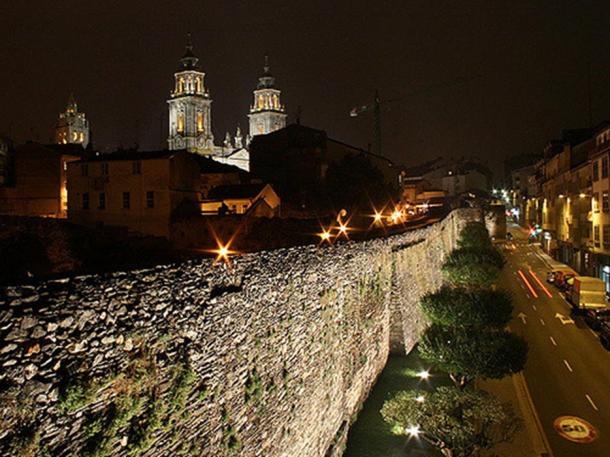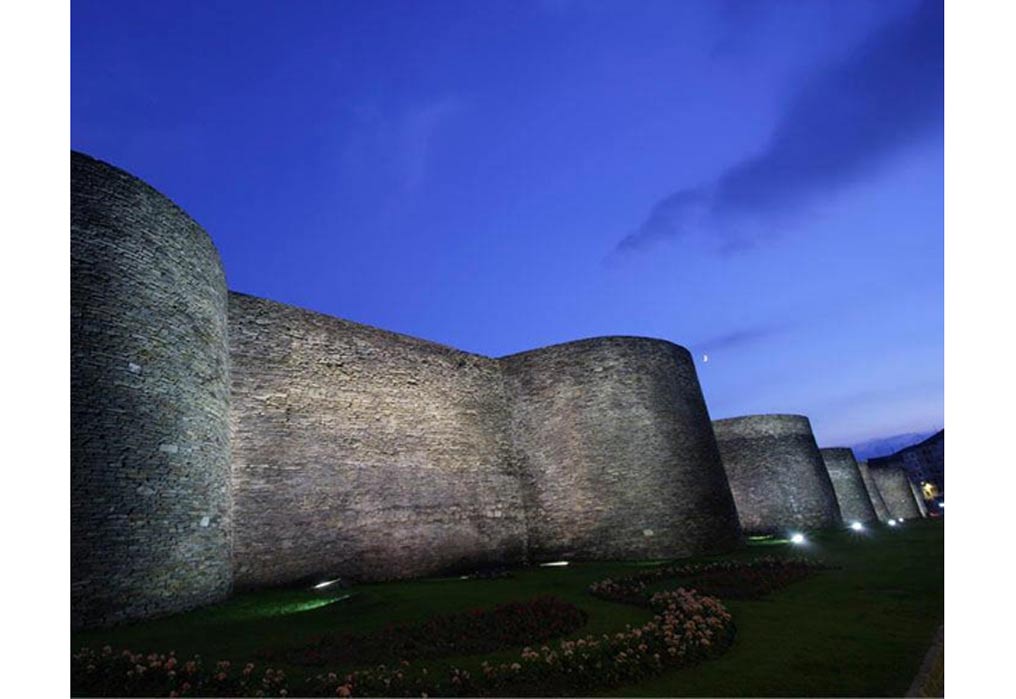Examining the Impressive Ancient Roman Walls of Lugo
The territory of Galicia in Spain was conquered by the Romans c. 61 BC. The army led by Julius Caesar changed the beautiful scenery of this part of the Iberian Peninsula forever. Over the centuries, the Romans created a number of impressive buildings and changed the urban landscape. One of the greatest remains of those times are the city of Lugo’s Roman walls.
Lugo was founded by Celtic inhabitants, or pre-Roman people, who lived in Galicia. The first name of the city comes from the name of the Pan-Celtic God of light, arts, and oaths – Lugos. After the Romans conquered Galicia, a man known as Paulus Fabius Maximus created the city called Lucus Augusti in place of the old settlement. The first military camp appeared there in 13 BC.
Nowadays, Lugo is a city which is 332 km2 (128 sq. mi), and has a population of 98,560 (in 2014). It is the only city in the world which is surrounded by totally intact Roman Walls.

Map signaling the gates in the wall of Lugo (Galicia, Spain) (CC BY-SA 2.0)
The Great Roman Walls of Lugo
The Roman walls of Lugo (Muralla Romana de Lugo) were constructed between 263 and 276 AD. These walls still enclose a small city center which is the heart of the site. Even during Roman times, not all of the city was protected by the walls, but only the most important part of it. The temples, houses of the nobles, and other important buildings were inside the walls. The southeastern part of the city was unprotected by the walls, but supported with a number of the other fortifications.
- Golubac Fortress: The Best Preserved Medieval Fortress in Europe
- Irish Lore Keeper gives Dire Warning: US Company will be Cursed if Ancient Fairy Fort is Destroyed
- The Great Erebuni of the Uratian Kingdom: Fortress of Blood

Roman wall / Muralla romana, Lugo. (CC BY-NC-ND 2.0)
The walls reach a height of 10 to 15 meters (33 to 49 feet). They are 2,177 meters long (6,946 ft), and cover an area of 34.4 hectares. The circuit is ringed with 71 towers, and the walkway over the walls allows one to stroll along the entire length of the wall. The towers were built at irregular intervals. 49 of them are completely intact, but another 39 have only partially survived.
The walls consist of internal and external stone facing the core of the earth. It's a mixture of pebbles, gravel and worked Roman stone, cemented with water. The walls have been rebuilt over the centuries, but their shape has never been changed. Even many of the wall’s staircases are original.
The Roman Walls of Lugo still have 10 gates. Five of them are dated to the Roman times, but the other five were added after 1853 due to the expanding town population. Among the five original gates, the best preserved are the Porta Falsa and the Porta Miña. The second one is located near the only original vaulted arch set. The most popular gate is Porta Miña, which is on the way for pilgrimages to Santiago de Compostela.

An entrance of the Wall. (CC BY 2.0)
A Brief History of Roman Galicia
Before the Romans arrived in Galicia, it was a land of tribes with origins that are still uncertain. Many researchers suggest that the local tribes mixed with Celts who arrived in Galicia from Ireland or Brittany, but others believe that the Celtic aspect of Galicia is a fairy tale.

Walls of Lugo during the night. (CC BY-NC-ND 2.0)
Unfortunately, most of the knowledge about the tribes which lived in Galicia before the Roman invasion is also unknown. According to the Romans, people who they met in Galicia were “barbarians”, who spent the day fighting and night eating, drinking, dancing, and worshiping their ancient deities. More recent research shows that they were not as primitive as the Romans wanted to depict them. They probably had a feudal model of society, much more advanced than many people believed.
The first time Galicia appeared as an important location of a historical battle were the times of the Punic Wars between the Carthaginians and Romans. The southern part of Galicia was also perhaps an important place for Phoencians. During the Punic Wars, Hannibal decided to recruit many Galician people in his army. Henceforth, Galicians didn't want to become a part of the Roman Empire.
After conquering Iberia, the Romans had to face the Galician army in 137 BC during the battle at the river Douro. The army of c. 60,000 Galicians was destroyed by the Romans. The man who led the army – Decimus Junius Brutus – returned to Rome as a hero. At the end of his campaign, the Romans controlled the area of Galicia placed between the rivers Douro and Minho. The second invasion in 61 BC, led by Julius Caesar, took other parts of the region as well.

Depiction of Hannibal and his army crossing the Alps during the Second Punic War. (Public Domain)
The Romans in Galicia continued transforming of the region during the reign of Octavian, from 26 to 19 BC. After this period, Galicia seems to be completely under Roman control. During the 3rd century AD, Diocletian connected Galicia, Asturia, and other parts near this region, and created an administrative division. At the same time, the Romans built their famous walls in Lugo because of safety issues. Lucus Augusti became one of the most strategic Roman cities in Spain, so it was often attacked by the local tribesmen and Germanic invaders.
After the fall of Roman control in 409 AD, Galicia became the independent Kingdom of Gallecia (known also as Galliciense Regnum). The old Roman capital of Galicia, Braga (currently in Portugal), became the new capital of the Kingdom controlled by the Germanic tribe Suebi.
A Modern City with a Roman Soul
Life in Lugo has been centered within the Roman walls for many years. Near the walls there is an original Roman bridge and remains of many ancient places, including parts of Roman villas.
- Newly-discovered ancient fortress reveals architectural accomplishments of Vikings
- Ancient Roman fort in England may have been constructed to pay homage to Mithra or Sol Invictus
- Mysterious medieval fortifications buried in Poland detected with advanced imaging technology

Roman walls of Lugo. (CC BY-SA 2.0)
Although the impact of the Catholic church in Galicia is strong, local society is very proud of their Roman roots and protect the Roman sites with great care. The city created a visitor’s center dedicated to the walls - the Centro de Interpretación de la Muralla. The Roman Walls of Lugo are also protected by UNESCO as a World Heritage Site as the finest example of Roman fortification in Europe. In 2007, during an unusual ceremony, the Roman walls of Lugo were twinned with the Great Wall of China.
Featured image: Roman walls of Lugo. Source: (CC BY-NC-SA 2.0)
References:
A.Vilela, E.Alcorta, F. Arias, C. Carreño, J. López de Rego., La muralla de Lugo: patrimonio de la humanidad, 2004
A. Vilela, Origen de las edificaciones adosadas a la muralla de Lugo, 1974.


















